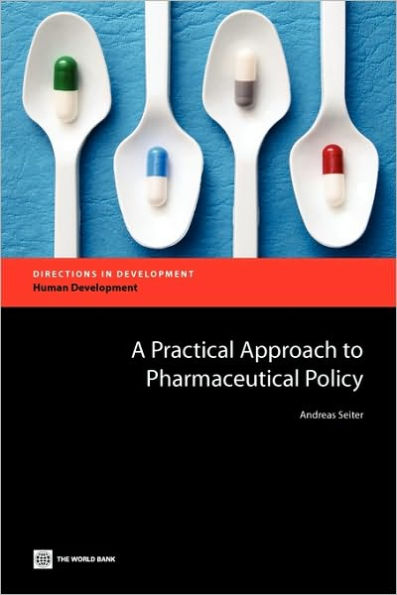A Practical Approach to Pharmaceutical Policy available in Paperback

- ISBN-10:
- 0821383868
- ISBN-13:
- 9780821383865
- Pub. Date:
- 06/17/2010
- Publisher:
- World Bank Publications
- ISBN-10:
- 0821383868
- ISBN-13:
- 9780821383865
- Pub. Date:
- 06/17/2010
- Publisher:
- World Bank Publications

Paperback
Buy New
$25.00Overview

Product Details
| ISBN-13: | 9780821383865 |
|---|---|
| Publisher: | World Bank Publications |
| Publication date: | 06/17/2010 |
| Series: | Directions in Development |
| Pages: | 238 |
| Product dimensions: | 5.90(w) x 8.90(h) x 0.60(d) |
Table of Contents
Foreword xi
Preface xiii
Acknowledgments xv
About the Author xvii
Abbreviations xix
Chapter 1 Pharmaceutical Policy Goals 1
Pharmaceutical Policy Framework 3
Parameters for Monitoring the Effect and Progress of Pharmaceutical Reforms 6
References 10
Chapter 2 Introducing the Stakeholders 11
Multinational Research-Based Companies 13
Multinational Generics Companies 18
National Generics Companies 21
Brokers 22
Procurement Agents 23
Importers and Agents 24
Wholesalers 25
Central Medical Stores 26
Retail Pharmacists and Drug Sellers 27
Prescribers 28
Consumers 29
Public Policy Makers: Legislative and Executive 30
Regulatory and Executive Agencies 31
Expert Commissions and Advisers 32
Civil Society Organizations 32
International Agencies and Donors 33
Public Purchasers 35
Payers 35
Pharmaceutical Benefit Managers 36
Consultants 36
Notes 37
References 38
Chapter 3 Patterns of Dysfunction 39
Inadequate Regulation of Core Pharmaceutical Sector Functions 41
Lack or Misuse of Funds 44
Ineffective or Inefficient Procurement 45
Dysfunctional Supply Chains 48
Corruption, Abuse of Public Funds, and Unethical Business Practices 51
Inadequate Incentives for Providers and Policy Makers 53
Medicine Prices Perceived as Too High 59
Conflicts between Innovation and Cost Containment 66
Conflicts between Industrial Policy and Public Health Objectives 71
Irrational or Inappropriate Use of Drugs 73
A Tool to Assess the Sector and Diagnose Dysfunctions 75
Notes 77
References 78
Chapter 4 Key Elements of a Successful Pharmaceutical Policy 81
Ensuring Access to Safe and Effective Drugs through Well Designed Supply Chains 82
Using Purchasing Power to Get Value for Money 93
Managing the Decision Process on Formulary Inclusion 97
Creating Adequate Information Systems 104
Ensuring Rational and Cost-Effective Use of Medicines 107
Securing Adequate Financing and Payment Mechanism for Pharmaceuticals 110
Reconciling Health Policy and Industrial Policy in the Pharmaceutical Sector 113
Ensuring Good Governance of the Sector 117
Notes 120
References 121
Chapter 5 Policy Packages to Achieve Strategic Long-Term Goals 123
Essential Medicines Policy 124
Generic Drugs Policy 126
Innovation-Friendly Drugs Policy 127
Combining Several Policy Models within One Country 128
Notes 129
Reference 129
Chapter 6 Factors Influencing Policy Implementation 131
Stakeholder Assessment and Involvement 132
Strategies to Neutralize Political Opposition 135
Note 137
Reference 137
Chapter 7 Pharmaceutical Policy Illustrated in Country Examples 139
Ghana: National Health Insurance as a "Game Changer" 139
Lithuania: Dealing with the Effects of the Financial Crisis 143
China: Improving Social Protection for the Rural Poor 145
Russian Federation: Affordability and Access to Essential Drugs 146
Liberia: Building Up after Conflict 147
Notes 149
References 149
Chapter 8 Pharmaceutical Policy Outlook 151
Regulatory Framework 151
Drug Prices 153
Financing and Management of Drug Benefits 154
Effect on Markets and Industry 155
General Trend: Convergence toward Models That Work 158
References 159
Appendix A A Tool to Assess the Pharmaceutical Sector in a Given Country 161
Appendix B Customized Version of the Assessment Tool (Appendix A) for Use in an Assessment of the Pharmaceutical Sector in Turkey 167
Part 1 Quantitative Data 169
Part 2 Descriptive Section 171
Appendix C Assessment Tool for Government Procurement Agencies in the Health Sector in India 175
Index 207
Boxes
1.1 Example of Target Setting in a Project Aimed at Improving Access to Medicines in a Low-Income Country 8
2.1 A Tragedy in Panama, Caused by a Toxic Ingredient in Cough Syrup 21
3.1 Major Cost Drivers for Ensuring Drug Availability in Health Centers in Lesotho 50
3.2 Fraudulent Abuse of Health Insurance Funds in Germany 53
3.3 Example of Price Regulation in Practice 62
3.4 NICE: Example of an Institution Set Up to Manage the Conflict between Innovation and Cost Containment in Health Care 69
3.5 Access to Medicines and the TRIPs Agreement in Brazil 70
